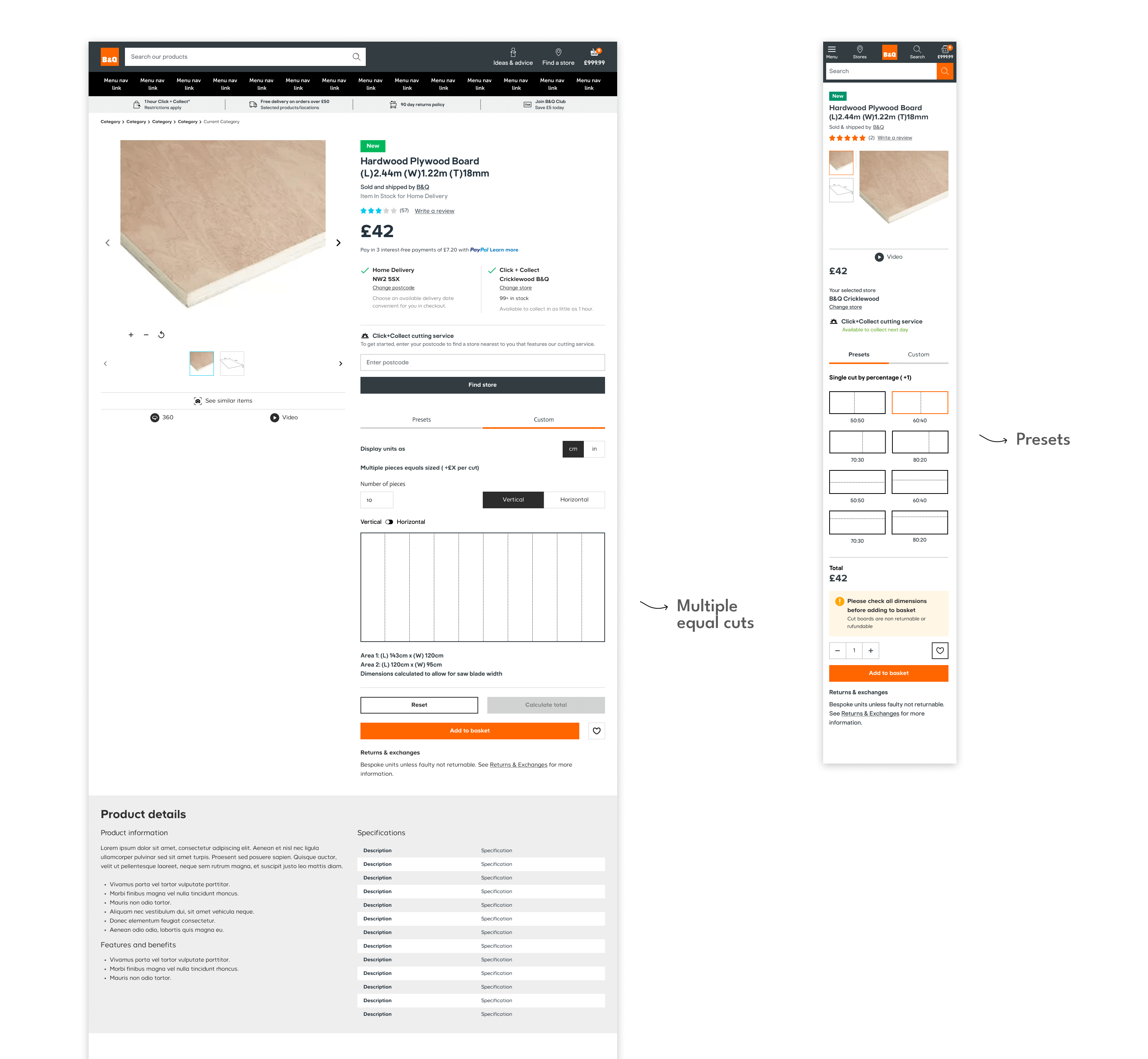B&Q - Cut to Size Timber Online Configurator
Brief Summary
This project aimed to innovate and validate a new business concept by extending the in-store cut-to-size offering to an online platform. We conducted research to understand user preferences and estimate the potential revenue of an online cut-to-size configurator. I was part of a cross-functional team that included a product owner, several developers, a researcher, and other departments from B&Q. As the product designer assigned to this team, I was involved throughout the entire design process.
More detailed explanation
Team & Role
During my tenure at Kingfisher from fall 2021, I engaged in diverse projects across multiple teams.
The primary focus of this case study is the development of a cut-to-size online configurator. As the Product designer, In collaboration with the research team I conducted research on the existing in-store offering, as well as the potential desire for an online cut to size service. Operating within a dynamic agile environment, I closely collaborated with cross-functional teams including the Product Owner, developers,the broader B&Q design team (including the team involved in the PDP), and other relevant teams integral to the facets this configurator could impact.
Problem Statement
Currently, there is only one route for a customer to get cut to-size timber, the in-store one.
There was a desire to investigate if offering an online alternative to order pre-cut products could increase the number of customers using the service and ultimately bring more revenue.
Design Process
User Research & Analysis
Before progressing on to other forms of design. I wanted to gain insight into validating the viability of providing an online cutting service. This was done with the hypothesis that customers would want to pay for the convenience of this service.

Research highlights
Target users: Anyone who want to do a DIY project and need some cut to size timber.
- Convenience: user doesn't need to have the right tools, no need to clean up the space after cutting
- Time saving: Avoid in store queues or in store lack of service availability (the saw operator might be on lunch break)
- Efficiency: Ability to quickly and effectively communicate what they want (no need to bring the measurements written on paper or in any device to the store) Ability to choose the timber from a list without having to bring it to the trolley and then go to the till
User Stories
The prior research served as a foundation for crafting user stories, which in turn informed design decisions during the ideation phase.
As a DIY customer seeking to buy timber, I would like to search for the correct timber for my purpose and to calculate the correct quantity and sizes. So I can be assured my timber purchase will meet my functional, aesthetic and budget objectives.
- User story 1 - Sheet timber - Pre defined cuts or presets Given I am a customer I want to purchase sheet timber pre-cut to size,
- User story 2 - Sheet timber - Multiple repeat cuts Given I am a customer
- User story 3 - Sheet timber - bespoke cuts
I want
1.To specify which of the available cuts I need
2.Choose a store with a band saw available
3.Ready for Click and Collect or delivery in my selected store
When I want to purchase sheet timber cut into even sections, Then I want
1.To specify the number and orientation of equal cuts I need
2.Choose a store with a band saw available
3.Ready for to Click and Collect or delivery in my selected store
Given I am a customer When I want to purchase timber with bespoke cuts Then I want
1. To specify the number, and orientation of straight cuts I need
2. See a representation of this online
3. Minimise any wastage
4. Choose a store with a band saw available
5.Ready for to Click and Collect or delivery in my selected store
Iterative Process


After analysing user goals and competitor strategies, I initiated wireframe creation to align the UX strategy with business objectives. This involved align with other team and investigating the functionality of the Product Listing Page (PLP) and Product Detail Page (PDP), focusing on integrating the new cut-to-size service seamlessly. Efforts were also made to align with the existing design system and strategise the integration of the cut-to-size configurator within the current PDP (Product Detail Page).
I began with mobile-first wireframes, incorporating a custom cut-to-size configurator with a 3D preview. This idea was inspired by competitor practices and feedback from users during research who expressed interest in visualizing their cuts. The feature would enables users to visualise cuts and identify situations where additions are not possible due to limited timber surface.
After consulting with developers, we concluded that implementing a custom cut-to-size configurator with a 3D preview was too complex due to challenges in developing the required algorithm. Instead, based on research showing customer preferences for even cuts, we iterated towards a solution offering standardised sizes, which proved more feasible for both user experience and development.
Final Proposal

Final Thoughts
Unfortunately, this project was not built due to an excessive number of dependencies and Kingfisher's ongoing technology transformation, and the project relied heavily on that. It is possible that this project may be revisited in the future. If that happens, there are expectations to conduct further user testing on the proposed versions in order to be sure the expectations of customers are meet for a cut-to-size online service.
